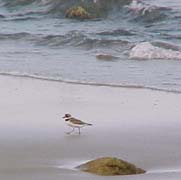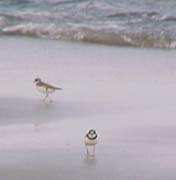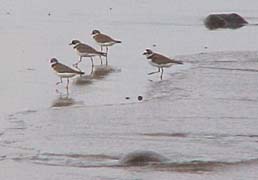|
Journal of a Sabbatical |
|||||||
|
July 13, 2000 |
|
life goes on - on the beach |
|||||
|
|
|
|
|||||
|
Today's Bird Sightings: South beach Visitors contacted: 29 Today's Reading: Cape Cod by Henry David Thoreau Today's Starting Pitcher: Pedro Martinez
Plum Island Bird List
Copyright © 2000, Janet I. Egan |
|
In any case, I am the south beach today being eaten by greenheads and numerous other beings. A ring billed gull nonchalantly walks along the beach and chomps on a greenhead in mid-flight. As I watch, it grabs another greenhead out of the air. I've always wondered what eats greenheads. I now have a whole new appreciation for ring billed gulls.
In between talking to visitors and swatting at greenheads, I got a chance to watch the Bonaparte's gulls closely. For the first time, I noticed them "paddling": standing in one spot moving the feet up and down rapidly and moving the head side to side rhythmically like it's looking for something. It's kind of like the foot-trembling behavior that plovers use to stir up the shallow water looking for prey. I read about this behavior in Niko Tinbergen's The Herring Gull's World, but I never saw a gull do it. According to Tinbergen, herring gulls do it in meadows, not in the inter-tidal zone. Since I am almost always watching gulls on the beach, I probably wouldn't see a herring gull do it. Tinbergen does say he saw common black-headed gulls doing it on the beach in shallow and muddy water, like what my Bonaparte's gulls were doing today. At the time The Herring Gull's World was published there was some disagreement in the scientific community about why gulls do this. I suspect the questions have been settled by now, but a quick search of the Internet yielded no insight tonight. Anyway, to me it sure looked like those Bonaparte's gulls were stirring up and eating little inter-tidal zone life forms. Four hours went by really quickly. A final greenhead got me just as I was writing my report so I got quite a bit of blood on the report form. Turning in a bloody report at the height of greenhead season, though not uncommon, struck me as hysterically funny this afternoon. It is the blood you have shed for your piping plovers that makes them so important (with apologies to the Little Prince and his rose). |
|||||
 The
south boundary has moved to just north of parking lot 7,
which, among other things, means I get an actual parking
space instead of trying to somehow squeeze my car into the
over full parking lot at Sandy Point. The beach is buzzing
with people, greenheads, Bonaparte's gulls, and semipalmated
plovers. It is the height of summer. Wicked hot.
The
south boundary has moved to just north of parking lot 7,
which, among other things, means I get an actual parking
space instead of trying to somehow squeeze my car into the
over full parking lot at Sandy Point. The beach is buzzing
with people, greenheads, Bonaparte's gulls, and semipalmated
plovers. It is the height of summer. Wicked hot. The
north boundary has also moved to just south of parking lot 1
as of today. I guess that northernmost piping plover pair
didn't make a go of it. The pair that nested there last year
failed too. I wonder if it's the same pair. I don't know
much about site fidelity in piping plovers.
The
north boundary has also moved to just south of parking lot 1
as of today. I guess that northernmost piping plover pair
didn't make a go of it. The pair that nested there last year
failed too. I wonder if it's the same pair. I don't know
much about site fidelity in piping plovers. Debbie,
the biologist, whizzed by on the ATV and gave me an update
on the invisi-birds. Another nest has hatched, with little
hatchlings running around. She spotted one fledgeling. Five
nests remain to hatch. They're running late this year
because of that storm we had in June and the unusually high
tide. The ones who got washed over renested. I told her I'd
just seen a fledgeling but suspected it had flown over from
Crane's Beach. She concurred and whizzed off to check on the
chicks at Sandy Point.
Debbie,
the biologist, whizzed by on the ATV and gave me an update
on the invisi-birds. Another nest has hatched, with little
hatchlings running around. She spotted one fledgeling. Five
nests remain to hatch. They're running late this year
because of that storm we had in June and the unusually high
tide. The ones who got washed over renested. I told her I'd
just seen a fledgeling but suspected it had flown over from
Crane's Beach. She concurred and whizzed off to check on the
chicks at Sandy Point.